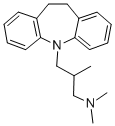| Identification | Back Directory | [Name]
TRIMIPRAMINE | [CAS]
739-71-9 | [Synonyms]
7162rp
il6001
RP-7162
FI 6120
IL 6001
7162 RP
Stangyl
Sapilent
Surmontil
Rhotrimine
TRIMIDRAMINE
Trimeprimina
Trimeprimine
TRIMIPRAMINE
Trimeproprimine
surmontil315695
Surmontil 315695
b-Methylimipramine
beta-Methylimipramine
Trimipramine solution
TRIMIPRAMINE USP/EP/BP
Trimipramine Solution, 100ppm
TRIMIPRAMINE,1.0MG/MLINMETHANOL
Trimipramine (base and/or unspecified salts)
2’-metil-3’-dimetilamino-propil-5-iminodibenzile
2'-Metil-3'-dimetilamino-propil-5-iminodibenzile
5-(3-dimethylamino-2-methylpropyl)-10,11-dihydrodibenz(b,f)azepine
5H-Dibenz[b,f]azepine-5-propanamine,10,11-dihydro-N,N,b-trimethyl-
5H-Dibenz[b,f]azepine-5-propanamine, 10,11-dihydro-N,N,β-trimethyl-
f)azepine-5-propanamine,10,11-dihydro-n,n,beta-trimethyl-5h-dibenz(
1-(3-Dimethylamino-2-methylpropyl)-4,5-dihydro-2,3:6,7-dibenzazepine
10,11-Dihydro-5-(3-dimethylamino-2-methylpropyl)-5H-dibenz(b,f)azepine
5H-Dibenz[b,f]azepine-5-propanamine, 10,11-dihydro-N,N,beta-trimethyl-
f)azepine,10,11-dihydro-5-(3-(dimethylamino)-2-methylpropyl)-5h-dibenz(
f)azepine,5-(3-(dimethylamino)-2-methylpropyl)-10,11-dihydro-5h-dibenz(
5-(g-Dimethylamino-b-methylpropyl)-10,11-dihydro-5H-dibenzo[b,f]azepine
5-(3-(Dimethylamino)-2-methylpropyl)-10,11-dihydro-5H-dibenz(b,f)azepine
5H-Dibenz[b,f]azepine-5-propanamine, 10,11-dihydro-N,N,b-trimethyl- (9CI)
3-(10,11-Dihydro-5H-dibenzo[b,f]azepin-5-yl)-N,N,2-trimethyl-1-propanamine
5H-Dibenz(b,f)azepine, 10,11-dihydro-5-(3-(dimethylamino)-2-methylpropyl)-
5H-Dibenz[b,f]azepine, 5-[3-(dimethylamino)-2-methylpropyl]-10,11-dihydro-
5-(gamma-dimethylamino-beta-methylpropyl)-10,11-dihydro-5h-dibenzo(b,f)azepi
5-(gamma-Dimethylamino-beta-methylpropyl)-10,11-dihydro-5H-dibenzo(b,f)azepine
5H-Dibenz[b,f]azepine, 5-[3-(dimethylamino)-2-methylpropyl]-10,11-dihydro- (6CI, 7CI, 8CI) | [EINECS(EC#)]
212-008-3 | [Molecular Formula]
C20H26N2 | [MDL Number]
MFCD00242595 | [MOL File]
739-71-9.mol | [Molecular Weight]
294.43 |
| Chemical Properties | Back Directory | [Melting point ]
45° | [Boiling point ]
426.2°C (rough estimate) | [density ]
0.9912 (rough estimate) | [refractive index ]
1.6450 (estimate) | [Fp ]
9℃ | [storage temp. ]
2-8°C | [pka]
pKa 8.0 (Uncertain) |
| Hazard Information | Back Directory | [Originator]
Surmontil Wyeth-Ayerst,Laboratories | [Uses]
Antidepressant. | [Definition]
ChEBI: A dibenzoazepine that is 10,11-dihydro-5H-dibenzo[b,f]azepine substituted by a 3-(dimethylamino)-2-methylpropyl group at the nitrogen atom. It is used as an antidepressant. | [Manufacturing Process]
Bis(3-dimethylamino-2-methylpropyl)-5-iminodibenzylyl carboxylic acid at
185-250°C up to discontinue a separation of oxyde carbonique. The product
was dissolved in ether, then washed with the hydrochloric acid. Then this
solution was extracted with ether. The solvent was evaporated under vacuum,
to give pure oil bis(3-dimethylamino-2-methyl-1-propyl)-5-iminodibenzyle with
boiling point 153-154°C at 0.4 mm. Maleate of bis(3-dimethylamino-2-methyl-
1-propyl)-5-iminodibenzyle have melting point 145-146°C. | [Brand name]
Surmontil (Wyeth-Ayerst);Apo-trimip;Herphonal;No-tripramine;Novo-tripramine;Rhotromine;Sapilant;Stangyl;Surmantil;Tydamine. | [Therapeutic Function]
Antidepressant | [World Health Organization (WHO)]
Trimipramine, a tricyclic antidepressant was introduced in 1961
for the management of endogenous depression. Much of the adverse effects are
caused by its antimuscarinic actions. These include dry mouth, cardiac
arrhythmias, central nervous system disturbances, blood disorders and risk of
suicide. The risk of suicide and dangers related to overdosage led Norwegian
Medicines Control Authority to put the higher strength formulation under
prescribing restriction in 1992. The risk of death following overdosage is
apparently higher for products containing tricyclic compounds as compared with
nontricyclic products. | [Pharmacokinetics]
Trimipramine is one of the antidepressants with the most pronounced differences in pharmacokinetics caused
by the CYP2D6 genetic polymorphism. Its bioavailability and systemic clearance depended
significantly on the CYP2D6 isoform with a linear dose relationship. Its mean bioavailability was 44% in
individuals without CYP2D6 (poor metabolizers) but 16 and 12% in those individuals with two and three active
genes of CYP2D6 (fast and ultrafast metabolizers), respectively. Consequently, the mean total clearances of
the oral dose were 27, 151, and 253 L/hour in poor, extensive, and ultrarapid metabolizers, respectively. The
44% bioavailability combined with low systemic clearance of trimipramine in poor metabolizers of CYP2D6
substrates results in a very high exposure to trimipramine with the risk of adverse drug reactions. On the
other hand, the presystemic elimination may result in subtherapeutic drug concentrations in carriers of
CYP2D6 gene duplications with a high risk of poor therapeutic response | [Clinical Use]
Although trimipramine has the weakest binding affinity for the monoamine transporters, it shares the pharmacological and toxicity actions of the other TCAs and is used primarily in the
treatment of depression. | [Drug interactions]
Potentially hazardous interactions with other drugs
Alcohol: increased sedative effect.
Analgesics: increased risk of CNS toxicity with
tramadol; possibly increased risk of side effects with
nefopam; possibly increased sedative effects with
opioids.
Anti-arrhythmics: increased risk of ventricular
arrhythmias with amiodarone - avoid; increased
risk of ventricular arrhythmias with disopyramide,
flecainide or propafenone; avoid with dronedarone.
Antibacterials: increased risk of ventricular arrhythmias
with delamanid and moxifloxacin and possibly
telithromycin - avoid with delamanid and moxifloxacin.
Anticoagulants: may alter anticoagulant effect of
coumarins.
Antidepressants: enhanced CNS excitation and
hypertension with MAOIs and moclobemide -
avoid; concentration possibly increased with SSRIs;
risk of ventricular arrhythmias with citalopram
and escitalopram - avoid; possible increased risk of
convulsions with vortioxetine.
Antiepileptics: convulsive threshold lowered;
concentration reduced by carbamazepine,
phenobarbital and possibly fosphenytoin, phenytoin
and primidone.
Antimalarials: avoid with artemether/lumefantrine
and piperaquine with artenimol.
Antipsychotics: increased risk of ventricular
arrhythmias especially with droperidol, fluphenazine,
haloperidol, pimozide, sulpiride and zuclopenthixol
- avoid; increased risk of ventricular arrhythmias
with risperidone; increased antimuscarinic effects
with clozapine and phenothiazines; concentration
increased by antipsychotics.
Antivirals: increased risk of ventricular arrhythmias
with saquinavir - avoid; concentration possibly
increased with ritonavir.
Atomoxetine: increased risk of ventricular
arrhythmias and possibly convulsions.
Beta-blockers: increased risk of ventricular
arrhythmias with sotalol.
Clonidine: tricyclics antagonise hypotensive effect;
increased risk of hypertension on clonidine withdrawal.
Dapoxetine: possibly increased risk of serotonergic
effects - avoid.
Dopaminergics: avoid use with entacapone; CNS
toxicity reported with selegiline and rasagiline.
Pentamidine: increased risk of ventricular
arrhythmias.
Sympathomimetics: increased risk of hypertension
and arrhythmias with adrenaline and noradrenaline;
metabolism possibly inhibited by methylphenidate. | [Metabolism]
Trimipramine is metabolised in the liver to its major
metabolite desmethyltrimipramine, which is active.
Trimipramine is excreted in the urine mainly in the form
of its metabolites. |
|
| Company Name: |
LGM Pharma
|
| Tel: |
1-(800)-881-8210 |
| Website: |
www.lgmpharma.com |
| Company Name: |
BOC Sciences
|
| Tel: |
|
| Website: |
https://www.bocsci.com |
| Company Name: |
Cckinase, Inc.
|
| Tel: |
+1 (732)236-3202 |
| Website: |
www.cckinase.com |
| Company Name: |
Wuhan Topule
|
| Tel: |
+86-02787215551 +86-19945035818 |
| Website: |
http://www.topule.com/ |
|





